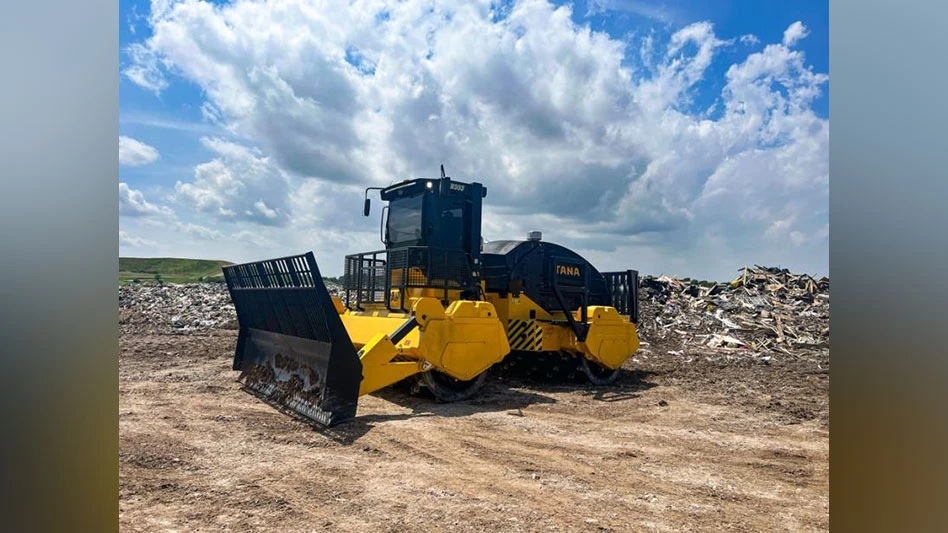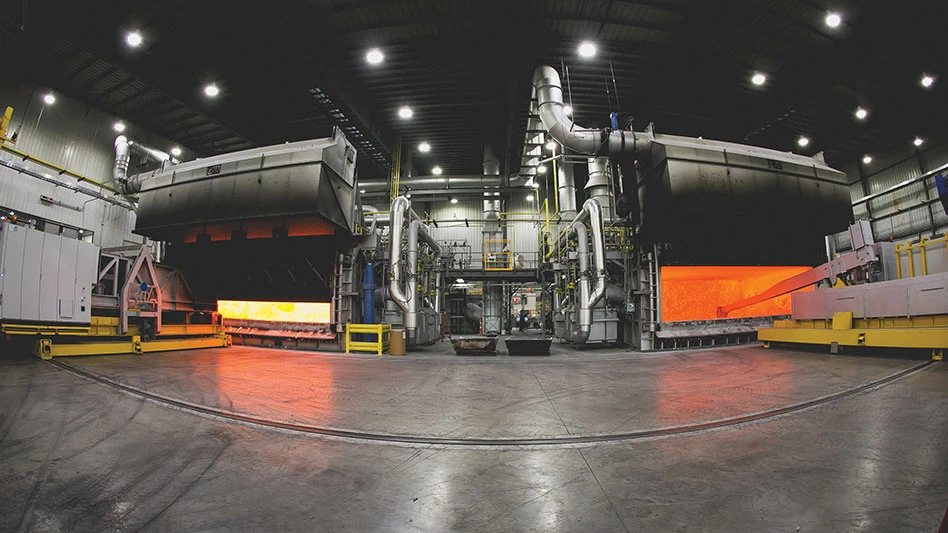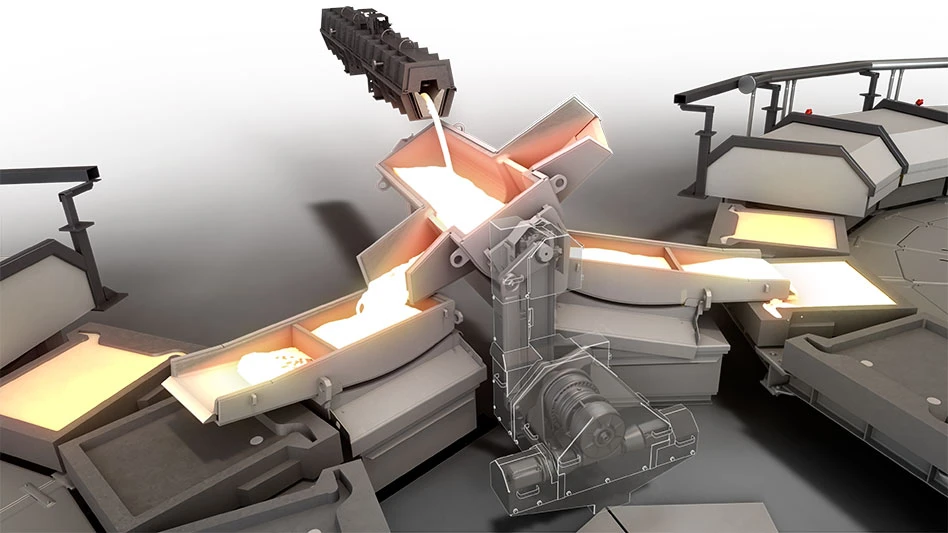Among the weightier decisions facing the person in charge of buying a scrap handler is what type of platform the machine should have. There are three common types of scrap handler platforms: wheeled, tracked and pedestal-mounted. Each platform offers different levels of stability and mobility and, most equipment dealers would agree, each platform has its place in the scrap processing industry. At a large scrap recycling facility, it is common to see all three configurations in use at different stages of the scrap moving and processing operation.
BIG WHEELS KEEP ON TURNING
Although it can be difficult to gauge outright scrap handler market share by platform, many industry participants believe wheeled scrap handlers have rolled into the passing lane. While no trend is across the board, consolidation and the need to centralize operations has resulted in scrap yards that are larger and contain more processing equipment than just a decade ago. Consequently, mobility has become greatly valued by many processors. In general, wheeled handlers can move around the yard more quickly than those on treads, and if needed can even be used off-site if such a situation arises.
Environmental standards have resulted in a great deal of paving at scrap processing facilities throughout North America. As concrete is poured at more and more yards, wheels become a platform option that can make sense. “The trend toward wheeled handlers is really gaining momentum,” says one dealer of scrap handlers. “I would say that nearly every yard today has at least one wheeled handler, and those that have completed a lot of paving have numerous wheeled handlers.”
In Europe, as many as 90% of the scrap handlers are estimated to be of the wheeled configuration, according to manufacturers who sell equipment there. Concrete at facilities in Europe has proliferated due to strict environmental regulations adopted to bring all nations in line with European Union standards.
Storm water runoff standards outlined by the U.S. Environmental Protection Agency (EPA) are steering many scrap processors to pour concrete over areas of their yard that were formerly unpaved. (A decrease in the generation of dust has been an added benefit of paved surfaces, many yard operators have found.) Paving is among the nearly 200 “best management practices” for scrap yards to control storm water runoff recommended by the EPA.
“Yards are finding that it is in their best interest to stay ahead of the regulations,” says one scrap processor. “We have our entire nonferrous operation under roof, and our ferrous operation outside is entirely paved. That portion of the yard is on a gradual slope, so any runoff is collected at a drain at the end and goes through a separation process that removes any major contaminants.”
Even with “clean” scrap, there are residual metals present in storm water runoff that can be considered hazardous, and the EPA is concerned about what affect, if any, that may have on the environment.
Once the pavement is in place, scrap processors have to keep an eye out to treating the pavement with care. “You don’t want to be dropping large, heavy pieces of scrap on the pavement, and you don’t want to tear it up with crawlers,” says one processor. “So, we have turned to tired handlers to work on the pavement, and if a crawler needs to work on the pavement we instruct the operator to be extra careful when moving and turning.”
Operators of wheeled scrap handlers have one more decision to consider: whether to use foam-filled or solid tires. One crane conversion specialist strongly recommends solid tires to his scrap-handling customers, most of whom operate in non-paved settings. “I recommend solid in most cases, he says. He recounts the story of one customer who decided against solid tires initially, but “60 days later he called to say the tires had fallen apart, and he asked for some solid tire manufacturer recommendations.”
By most accounts, paved yards have proven to be ideal working environments for scrap handlers with tires. A paved surface is one that lets the wheeled handler take full advantage of its mobility. Some handlers are being designed to offer more maneuverability in tight spaces than their predecessors did. These newer models have smaller footprints and features such as dual-axle steering that enable them to move quickly around the yard.
TREADING INTO HARSH TERRITORY
Although the trend toward paving appears to be legitimate and long-lasting, there are still many yards in operation with an exposed soil surface at part or all of their site. And even in the face of a trend toward paving, companies that offer treaded models are introducing innovations to make sure crawlers retain a place in the scrap processing facilities of the next century.
“It’s still the most durable design on the market,” says one manufacturer regarding tracked platforms, “and scrap processors like that.”
One crane conversion specialist notes that yard conditions often make treads the most sensible platform for small and medium-sized processors. “If they’re in a do-all market, but can only afford one crane, they tend toward track,” he notes. “Even a lot of larger processors who may have two or three yards—and they like the mobility of wheels—can find that conditions don’t favor tires. If they’re near a river in alluvial conditions, it can be muddy a great deal of the time.”
Another perceived benefit: the weighty crawler configuration can keep the handler’s center of gravity lower, usually eliminating the need for outriggers that are common with wheeled handlers.
The addition of rubber pads on the tracks of crawlers is one way to minimize damage to pavement. “The pads have worked well, and we paved our yard with extra-thick concrete so that it is more durable,” remarks one processor.
The value of the pads may vary regionally, however, with some processors claiming that the pads do not offer maximum traction in harsh winter weather. “It is certainly fine in warmer climates, but if the pavement is slick or icy, the crawler can loose traction and slip, and you don’t want that happening when you are handling scrap,” says one manufacturer.
Among the features to note when comparison shopping for crawlers is the design of the undercarriage. “You want the underneath of the handler to be free of obstructions and dangling hydraulic lines,” says one manufacturer.
PUT ON A PEDESTAL
Standing apart from its mobile co-workers is the stationary or pedestal-mounted crane. While there are operational trends that may favor mobile scrap handlers in many applications, most agree that there are still niches for the stationary crane. Manufacturers and vendors of stationary handlers cite several advantages of the platform, and also list several applications for which stationary scrap handlers are well-suited
Energy cost savings is often the first advantage mentioned. By using an electric motor, energy cost savings of as much as 75% may be possible compared to operating a diesel-fueled machine, according to one manufacturer. The use of electricity also offers an exhaust-free method of operation, and cuts down on engine noise.
Some manufacturers also claim a cycle time advantage for stationary cranes, noting that the equipment can be designed to operate specifically for a given application and operators can be trained to maximize efficiency performing that one function.
Efficiency is also enhanced by the elevated height of the crane operator’s cab, some fans of pedestal-mounted cranes contend. “The operator is physically high enough to oversee the entire area,” says one processor who owns a pedestal-mounted scrap handler.
Pedestal-mounted cranes can also be configured to offer a reach advantage (though some would argue the advantage is negated by the machine’s inability to move itself closer to other sites). Since the handler is securely fastened to the ground, the reach can be significantly extended without fears of tipping.
Models configured as equilibrium cranes use a moveable counterweight that is mechanically attached to the stick. As the counterweight moves up and down, the stick moves down and up. “This design keeps the crane in perfect balance at all times, reducing stress on the entire system,” says a manufacturer.
Several applications are most commonly associated with pedestal-mounted cranes, including the feeding of large shredders and the loading of scrap barges. “If there is a heavy-duty shredder or shear that needs to be constantly fed, it makes sense to have a dedicated scrap handler associated with that system,” says one processor.
While stationary cranes are popular in larger yards and at yards with access to port facilities, other types of yards also are considering them. The reach of one such crane can equal that of as many as four shorter-reach scrap handers, according to one manufacturer. “As more yards consolidate and add super-sized shredders, the stationary crane is a natural choice,” says the manufacturer.
SOME STAY ON TRACK WITH RAIL CRANES
While wheels, treads and pedestals are the most common platforms for scrap handling machines, there is one other notable option available: the rail-mounted crane. The use of rail-mounted material handlers, of course, is limited to those with on-site rail capabilities. But the market for such cranes, whether of the hydraulic or lattice-boom configuration, still exists.
Among those choosing rail-mounted cranes as an efficient option are steel mini-mill scrap consumers and large scrap yards that do a lot of rail shipping. Having the benefits of the faster, newer hydraulic material handler in particular, while still being able to operate on rail, is seen as an advantage by these users.
Rail-mounted cranes used in scrap applications have often been refurbished after having worked in a more general cargo setting. Often, the main frame of the lower part of the unit has been inspected to ascertain its structural soundness. The rail unit should not have had excessive ballast or counterweight added in an attempt to increase over-the-side lift capacity. Any additional weight can lead to frame fatigue and possible structural failures.
On hydraulic models, it is also important to have the proper size rail undercarriage match the capacity of the hydraulic material handling upper. Rail-mounted cranes can now be purchased using newly-manufactured rail undercarriages. The benefits of buying a new unit include having a factory warranty, having access to original manufacturers’ spare parts, and having accompanying valid, engineered lift charts.
At one time, locomotive cranes had a major presence in the scrap handling market. But the popularity of hydraulic handlers with crawler and wheeled platforms often came at the expense of rail-mounted machines. The availability of crawler models—combined with the growth of shipping scrap by truck—greatly decreased the relative advantages of rail-mounted cranes.
“Before hydraulic material handlers were made and marketed in the 1970s, if you needed mobility, you got a locomotive crane,” says one seller of new and pre-owned cranes. The hydraulic material handlers put locomotive cranes at a competitive disadvantage, he notes. “In the mid-’70s, they had new crawler models available for $250,000. A new locomotive crane was over $400,000, plus you needed an experienced and highly-skilled operator to run the lattice boom model,” he adds.
Manufacturers of rail-mounted cranes have subsequently taken steps to address the price and operational inequities that had put them on the defensive. Many new models now feature the hydraulic configuration instead of the lattice boom set-up. The manufacturers are hopeful that interest from steel mini-mills, in particular, will spark a renewal in their market.
Sidebar
The “E” Crane
When people in the scrap handling industry say they have an “E” crane, they are normally referring to an electric-driven, hydraulically-operated equilibrium scrap handler. E cranes can also simply be electric-powered pedestal scrap handlers. In either case, the elimination of the diesel engine offers several potential advantages for the yard.
First, it reduces air and noise pollution at the site. Second, it provides a constant power source. And third, it significantly reduces engine maintenance.
Other advantages include a better view of operations because the scrap handler is usually set on a pedestal that is 20 or more feet off the ground. Also, large equilibrium cranes include a much longer reach than mobile handlers due to their inherent design, which incorporates a moveable counterweight. These two advantages, in particular, make the stationary crane ideal for loading heavy-duty shears and shredders, as well as loading and unloading barges, railcars and trucks.
“With more scrap operations consolidating,” says one marketer of scrap handlers, “we are seeing a growing need for super-sized shredders and larger processing equipment. This, in turn, is creating a demand for large, electric-driven stationary cranes that can adequately feed these machines.” Another manufacturer says that E cranes are also easier to operate and are less fatiguing to operators. Mark Phillips

Explore the June 1998 Issue
Check out more from this issue and find your next story to read.
Latest from Recycling Today
- Fenix Parts acquires Assured Auto Parts
- PTR appoints new VP of independent hauler sales
- Updated: Grede to close Alabama foundry
- Leadpoint VP of recycling retires
- Study looks at potential impact of chemical recycling on global plastic pollution
- Foreign Pollution Fee Act addresses unfair trade practices of nonmarket economies
- GFL opens new MRF in Edmonton, Alberta
- MTM Critical Metals secures supply agreement with Dynamic Lifecycle Innovations






